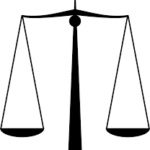
Justice symbol
| Symbol | Justice |
| Religion | Various religious and cultural contexts |
| Origin | The symbol of justice has ancient origins and is rooted in various cultural and religious traditions worldwide. Its exact origin is difficult to pinpoint due to its pervasive presence across different civilizations. |
| Meaning | Justice symbolizes fairness, equity, impartiality, and the balancing of rights and responsibilities. It represents the ideal of treating individuals and groups with fairness and equality under the law. |
| Appearance | The symbol of justice commonly features a few distinctive elements: Scales: Representing the weighing of evidence and arguments to achieve a fair outcome. Sword: Symbolizing the power and authority of justice to enforce laws and uphold rights. Blindfold: Signifying impartiality and the idea that justice should be blind, applying equally to all without bias or prejudice. |
| Colors | The colors associated with justice symbols can vary, but they often include: White: Symbolizing purity, neutrality, and truth. Gold: Representing the value and importance of justice. Black: Symbolizing the impartiality of justice and its ability to transcend personal biases. |
| Usage | The symbol of justice is prominently used in legal institutions, courtrooms, government buildings, and in representations of legal professions, such as statues and seals |
| History | The symbol of justice has a long history, dating back to ancient civilizations such as Mesopotamia, Egypt, and Greece. It has evolved over time, adapting to different cultural contexts and legal systems. |
| Popularity | The symbol of justice is widely recognized and used globally, reflecting its universal importance in legal and moral frameworks. |
| Importance | Justice is a fundamental principle in societies, serving as the cornerstone of legal systems and social order. The symbol of justice reinforces the importance of fairness, equality, and the rule of law. |
| Complexity | The concept of justice is complex and multifaceted, encompassing legal, moral, social, and philosophical dimensions. Its symbol reflects this complexity through its various elements and interpretations. |
| Emotions | The symbol of justice can evoke a range of emotions, including trust, hope, reassurance, and sometimes controversy or disillusionment when perceived injustices occur. |
The most common symbol of justice is undoubtedly the scales, often depicted as a balanced scale held by a blindfolded figure. This powerful image carries a rich history and complex meaning:
- Balance: The scales represent the core principle of justice: fairness and impartiality. Each side of the scale weighs evidence and arguments without bias, ensuring equality before the law.
- Blindfold: The blindfold signifies that justice is blind to external factors like wealth, status, or personal relationships. It represents the ideal that justice is applied objectively, based solely on the merits of each case.
- Figure: Traditionally, the figure holding the scales is Lady Justice, a blindfolded woman often dressed in robes. This image originated from ancient Greece and Rome, where goddesses like Themis and Justitia embodied justice.
While the scales and blindfolded figure are the most recognizable symbols, other elements can represent justice as well:
- The sword: Symbolizing authority and the power to enforce justice.
- Law books: Representing the legal system and its rules.
- Dove: Signifying peace and reconciliation.
- Broken chains: Depicting freedom from oppression.
The symbolism of justice is universal and powerful, recognized across cultures and throughout history. It serves as a reminder of the ongoing pursuit of fairness, impartiality, and equality in all aspects of society.